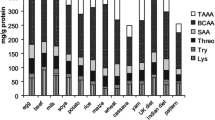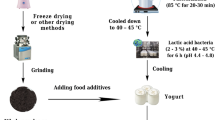Abstract
Fructans contribute significantly to dietary fiber with beneficial effects on gastrointestinal physiology in healthy individuals and offer a promising approach to treating some diseases. Two experiments (Experiment 1 = rats with normal weight; Experiment 2 = obese rats) were developed to compare the effects of three fructan sources (Cichorium intybus L. Asteraceae, Helianthus tuberosus L. Asteraceae and Agave angustifolia ssp. tequilana Haw, Agavaceae) on body weight change, blood metabolites and fecal bacteria in non-diabetic (ND) and diabetic (D) rats. In Experiment 1 total body weight gain and daily feed intake in D and ND rats decreased (P < 0.05) with supplements of fructan. Only in D rats, blood glucose concentrations, fecal Clostrodium spp. counts, and liver steatosis decreased, while blood HDL concentrations and fecal Lactobacillus spp. and Bifidobacterium spp. counts increased due to fructans. In Experiment 2, total body weight gain and feed intake in ND and D rats were also decreased by fructans. In ND rats, fructan decreased blood glucose concentrations. In D rats, fructans from A. angustifolia ssp. tequilana decreased blood cholesterol and LDL and liver steatosis. For both ND and D rats, fecal Lactobacillus spp. and Bifidobacterium spp. counts were higher (P < 0.05) with fructan supplements.
Similar content being viewed by others
Abbreviations
- D:
-
Diabetic rats
- DP:
-
Degree of polymerization
- ND:
-
Non-diabetic rats
References
Haslam DW, James WP (2005) Obesity. Lancet 366:1197–1209
Kotronen A, Yki-Järvinen H, Sevastianova K, Bergholm R, Hakkarainen A, Pietiläinen KH, Juurinen L, Lundbom N, Sørensen TIA (2011) Comparison of the relative contributions of intra-abdominal and liver fat to components of the metabolic syndrome. Obesity 19:23–28
Laville M, Nazare JA (2009) Diabetes, insulin resistance and sugars. Obes Rev 10(suppl 1):24–33
Weickert MO, Pfeiffer AF (2008) Metabolic effects of dietary fiber consumption and prevention of diabetes. J Nutr 138:439–442
Brighenti F (2007) Dietary fructans and serum triacylglycerols: A meta-analysis of randomized controlled trials. J Nutr 137:2552S–2556S
Cani PD, Lecourt E, Dewulf EM, Sohet FM, Pachikian BD, Naslain D, De Backer F, Neyrinck AM, Delzenne NM (2009) Gut microbiota fermentation of prebiotics increases satietogenic and incretin gut peptide production with consequences for appetite sensation and glucose response after a meal. Am J Clin Nutr 90:1236–1243
Alarcon-Aguilar JJ, Fortis-Barrera A, Angeles-Mejia S, Banderas-Dorantes TR, Jasso-Villagomez EI, Almanza-Perez JC, Blancas-Flores G, Zamilpa A, Diaz-Flores M, Roman-Ramos R (2010) Anti-inflammatory and antioxidant effects of a hypoglycemic fructan fraction from Psacalium peltatum (H.B.K.) Cass. in streptozotocin-induced diabetes mice. J Ethnopharmacol 132:400–407
Choque-Delgado GT, Tamashiro WMSC, Pastore GM (2010) Immunomodulatory effects of fructans. Food Res Int 43:1231–1236
Sarkar S, Pranava M, Marita RA (1996) Demostration of the hyperglycemic action of Momordica charantia in a validated animal model of diabetes. Pharmacol Res 33:1–4
Yang D, Chang YY, Hsu CL, Liu CW, Lin YL, Lin YH, Liu KC, Chen YC (2010) Antiobesity and hypolipidemic effects of polyphenol-rich longan (Dimocarpus longans Lour.) flower water extract in hypercaloric-dietary rats. J Agric Food Chem 10:2020–2027
Su P, Henriksson A, Mitchell H (2007) Prebiotics enhance survival and prolong the retention period of specific probiotic inocula in an in vivo murine model. J Appl Microbiol 103:2392–2400
Kleiner DE, Brunt EM, Van Natta M, Behling C, Contos MJ, Cummings OW, Ferrell LD, Liu YC, Torbenson MS, Unalp-Arida A, Yeh M, McCullough AJ, Sanyal AJ (2005) Design and validation of a histological scoring system for nonalcoholic fatty liver disease. Hepatology 41:1313–1321
SAS (1999) User´s Guide: Statistics [CD-ROM Computer file]. Version 8. SAS Inst. Inc. Cary, NC USA
Parnell JA, Reimer RA (2009) Weight loss during oligofructose supplementation is associated with decreased ghrelin and increased peptide YY in overweight and obese adults. J Clin Nutr 89:1751–1759
Sánchez D, Moulay L, Muguerza B, Quiñones M, Miguel M, Aleixandre A (2010) Effect of a soluble cocoa fiber-enriched diet in Zucker fatty rats. J Med Food 13:621–628
Cani PD, Knauf C, Iglesias MA, Drucker DJ, Delzenne NM, Burcelin R (2006) Improvement of glucose tolerance and hepatic insulin sensitivity by oligofructose requires a functional glucagon-like peptide-1 receptor. Diabetes 55:1484–1490
Van Loo J (2004) The specificity of the interaction with intestinal bacterial fermentation by prebiotics determines their physiological efficacy. Nutr Res Rev 17:89–98
Biedrzycka E, Bielecka M (2004) Prebiotic effectiveness of fructans of different degrees of polymerization. Trends Food Sci Technol 15:170–175
Pompei A, Cordisco L, Raimondi S, Amaretti A, Pagnoni UM, Matteuzzi D, Rossi M (2008) In vitro comparison of the prebiotic effects of two inulin-type fructans. Anaerobe 14:280–286
Alexiou H, Franck A (2008) Prebiotic inulin-type fructans: Nutritional benefits beyond dietary fibre source. Nutr Bull 33:227–233
Reimer RA, McBurney MI (1996) Dietary fiber modulates intestinal proglucagon messenger ribonucleic acid and postprandial secretion of glucagon-like peptide-1 and insulin in rats. Endocrinology 137:3948–3956
Tappenden KA, Thomson AB, Wild GE, McBurney MI (1996) Short-chain fatty acids increase proglucagon and ornithine decarboxylase messenger RNAs after intestinal resection in rats. J Parenter Enteral Nutr 20:357–362
Massimino SP, McBurney MI, Field CJ, Thomson ABR, Keelan M, Hayek MG, Sunvold GD (1998) Fermentable dietary fiber increases GLP-1 secretion and improves glucose homeostasis despite intestinal glucose transport capacity in healthy dogs. J Nutr 128:1786–1793
Dumoulin V, Moro F, Barcelo A, Dakka T, Cuber JC (1998) Peptide YY, glucagon-like peptide-1, and neurotensin responses to luminal factors in the isolated vascularly perfused frat ileum. Endocrinology 139:3780–3786
Cani PD, Dewever C, Delzenne NM (2004) Inulin-type fructans modulate gastrointestinal peptides involved in appetite regulation (glucagon-like peptide-1 and ghrelin) in rats. Br J Nutr 92:521–526
Urías-Silvas JE, Cani PD, Delmée E, Neyrinck A, López MG, Delzenne NM (2008) Physiological effects of dietary fructans extracted from Agave tequilana Gto. and Dasylirion spp. Br J Nutr 99:254–261
Hashimoto N, Noda T, Kim S, Sarker MZ, Yamauchi H, Takigawa S, Matsuura-Endo C, Susuki T, Han K, Fukushima M (2009) Yam contributes to improvement of glucose metabolism in rats. Plant Foods for Hum Nutr 64:193–198
Siok-Koon Y, Lay-Gaik O, Ting-Jin L, Min-Tze L (2009) Antihypertensive properties of plant-based prebiotics. Int J Mol Sci 10:3517–3530
Večeřa R, Orolin J, Škottová N, Kazdová L, Oliyarnik O, Ulrichová J, Šmináek V (2007) The influence of Maca (Lepidium meyenii) on antioxidant status, lipid and glucose metabolism in rat. Plant Foods for Hum Nutr 62:59–63
Beylot M (2005) Effects of inulin-type fructans on lipid metabolism in man and in animal models. Br J Nutr 93(suppl 1):S163–S168
Browning JD, Horton JD (2004) Molecular mediators of hepatic steatosis and liver injury. J Clin Investigation 114:147–152
Donnelly KL, Smith CI, Schwarzenberg SJ, Jessurun J, Boldt MD, Parks EJ (2005) Sources of fatty acids stored in liver and secreted via lipoproteins in patients with nonalcoholic fatty liver disease. J Clin Investig 115:1343–1351
Jurgoński A, Juśkiewicz J, Zduńczyk Z (2008) Ingestion of black chokeberry fruit extract leads to intestinal and systemic changes in a rat model of prediabetes and hyperlipidemia. Plant Foods for Hum Nutr 63:176–182
Delzenne NM, Daubioul C, Neyrinck A, Lasa M, Taper HS (2002) Inulin and oligofructose modulate lipid metabolism in animals: review of biochemical events and future prospects. Br J Nutr 87(suppl 2):S255–S259
Hellwege EM, Raap M, Gritscher D, Willmitzer L, Heyer AG (1998) Differences in chain length distribution of inulin from Cynara scolymus and Helianthus tuberosus are reflected in a transient plant expression system using the respective 1-FFT cDNAs. FEBS Lett 427:25–28
López MG, Mancilla-Margalli NA, Mendoza-Díaz G (2003) Molecular structures of fructans from Agave tequilana Weber var. azul. J Agric Food Chem 51:7835–7840
Mancilla-Margalli NA, López MG (2006) Water-soluble carbohydrates and fructan structure patterns from Agave and Dasylirion species. J Agric Food Chem 54:7832–7839
Gómez E, Tuohy KM, Gibson GR, Klinder A, Costabile A (2010) In vitro evaluation of the fermentation properties and potential prebiotic activity of Agave fructans. J Appl Microbiol 108:2114–2121
Acknowledgments
This research was funded by UASLP Funds C08-FAI-04-27.31 and by CONACyT through a master of science scholarship (208836) granted to Juan Antonio Rendón-Huerta. We thank to BNP Qingdao Co (China) for kindly supplying Helianthus tuberosus fructans
Author information
Authors and Affiliations
Corresponding author
Rights and permissions
About this article
Cite this article
Rendón-Huerta, J.A., Juárez-Flores, B., Pinos-Rodríguez, J.M. et al. Effects of Different Sources of Fructans on Body Weight, Blood Metabolites and Fecal Bacteria in Normal and Obese non-diabetic and Diabetic Rats. Plant Foods Hum Nutr 67, 64–70 (2012). https://doi.org/10.1007/s11130-011-0266-9
Published:
Issue Date:
DOI: https://doi.org/10.1007/s11130-011-0266-9




